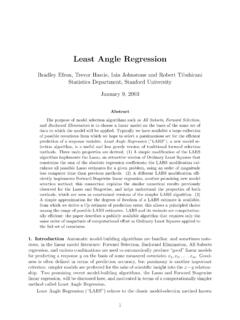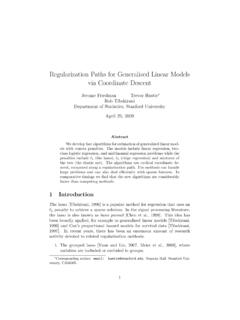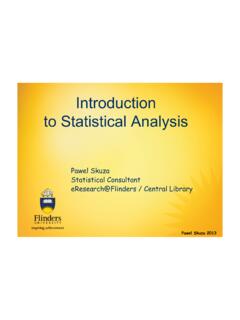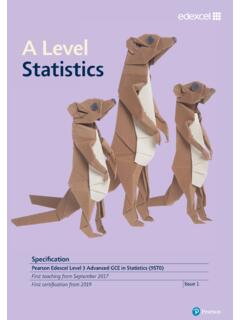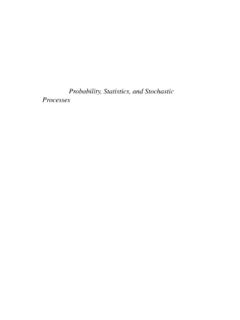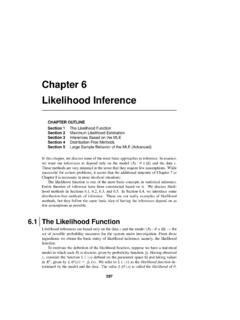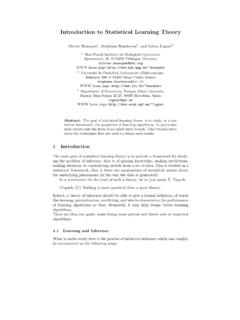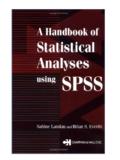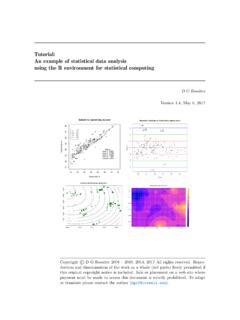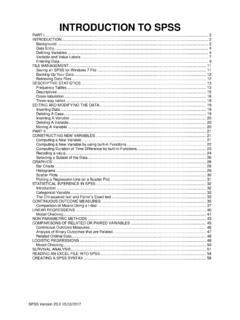Transcription of COMPUTER AGE STATISTICAL I NF ER C
1 The twenty-first century has seen a breathtaking expansion of STATISTICAL methodology, both in scope and in influence. Big data, data science, and machine learning have become familiar terms in the news, as STATISTICAL methods are brought to bear upon the enormous data sets of modern science and commerce. How did we get here? And where are we going?This book takes us on an exhilarating journey through the revolution in data analysis following the introduction of electronic computation in the 1950s. Beginning with classical inferential theories Bayesian, frequentist, Fisherian individual chapters take up a series of influential topics: survival analysis, logistic regression, empirical Bayes, the jackknife and bootstrap, random forests, neural networks, Markov chain Monte Carlo, inference after model selection, and dozens more. The distinctly modern approach integrates methodology and algorithms with STATISTICAL inference .
2 The book ends with speculation on the future direction of statistics and data & hastiEComputEr agE STATISTICAL inference How and why is computational statistics taking over the world? In this serious work of synthesis that is also fun to read, Efron and Hastie give their take on the unreasonable effectiveness of statistics and machine learning in the context of a series of clear, historically informed examples. Andrew Gelman, Columbia University COMPUTER Age STATISTICAL inference is written especially for those who want to hear the big ideas, and see them instantiated through the essential mathematics that defines STATISTICAL analysis. It makes a great supplement to the traditional curricula for beginning graduate students. Rob Kass, Carnegie Mellon University This is a terrific book. It gives a clear, accessible, and entertaining account of the interplay between theory and methodological development that has driven statistics in the COMPUTER age.
3 The authors succeed brilliantly in locating contemporary algorithmic methodologies for analysis of big data within the framework of established STATISTICAL theory. Alastair Young, Imperial College London This is a guided tour of modern statistics that emphasizes the conceptual and computational advances of the last century. Authored by two masters of the field, it offers just the right mix of mathematical analysis and insightful commentary. Hal Varian, Google Efron and Hastie guide us through the maze of breakthrough STATISTICAL methodologies following the computing evolution: why they were developed, their properties, and how they are used. Highlighting their origins, the book helps us understand each method s roles in inference and/or prediction. Galit Shmueli, National Tsing Hua University A masterful guide to how the inferential bases of classical statistics can provide a principled disciplinary frame for the data science of the twenty-first century.
4 Stephen Stigler, University of Chicago, author of Seven Pillars of STATISTICAL Wisdom A refreshing view of modern statistics. Algorithmics are put on equal footing with intuition, properties, and the abstract arguments behind them. The methods covered are indispensable to practicing STATISTICAL analysts in today s big data and big computing landscape. Robert Gramacy, The University of Chicago Booth School of BusinessBradley Efron is Max H. Stein Professor, Professor of Statistics, and Professor of Biomedical Data Science at Stanford University. He has held visiting faculty appointments at Harvard, UC Berkeley, and Imperial College London. Efron has worked extensively on theories of STATISTICAL inference , and is the inventor of the bootstrap sampling technique. He received the National Medal of Science in 2005 and the Guy Medal in Gold of the Royal STATISTICAL Society in 2014. Trevor Hastie is John A.
5 Overdeck Professor, Professor of Statistics, and Professor of Biomedical Data Science at Stanford University. He is coauthor of Elements of STATISTICAL Learning, a key text in the field of modern data analysis. He is also known for his work on generalized additive models and principal curves, and for his contributions to the R computing environment. Hastie was awarded the Emmanuel and Carol Parzen prize for STATISTICAL Innovation in 2014. Institute of Mathematical Statistics MonographsEditorial Board:D. R. Cox (University of Oxford)B. Hambly (University of Oxford)S. Holmes (Stanford University)J. Wellner (University of Washington)Cover illustration: Pacific Ocean wave, North Shore, Oahu, Hawaii. Brian Sytnyk / Getty designed by Zoe IN THE UNITED KINGDOMC omputEr agE STATISTICAL infErEnCEalgorithms, EvidEnCE, and data sCiEnCEBradlEy Efron trEvor hastiE9781107149892 Efron & Hastie JKT C M Y KThe Work, COMPUTER Age STATISTICAL inference , was first published by Cambridge University in the Work, Bradley Efron and Trevor Hastie, University Press s catalogue entry for the Work can be found athttp: // www.
6 Cambridge. org/9781107149892NB: The copy of the Work, as displayed on this website, can be purchased through Cambridge UniversityPress and other standard distribution channels. This copy is made available for personal use only and mustnot be adapted, sold or November 10, Age STATISTICAL InferenceAlgorithms, Evidence, and Data ScienceBradley EfronTrevor HastieStanford UniversityTo Donna and LyndaviiiContentsPrefacexvAcknowledgment sxviiiNotationxixPart I Classic STATISTICAL Inference11 Algorithms and Regression in and Details203 Bayesian Prior in Frequentist Bayesian/Frequentist Comparison and Details364 Fisherian inference and Maximum Likelihood and Maximum Information and the and and Details515 Parametric Models and Exponential Multivariate Normal s Information Bound for Multiparameter Multinomial and Details69 Part II Early COMPUTER -Age Methods736 Empirical Missing-Species Medical Evidence and Details887 James Stein Estimation and Ridge James Stein Baseball Evidence and Details1048 Generalized Linear Models and Regression Linear and Details1289 Survival Analysis and the EM Tables and Hazard Data and the Kaplan Meier Log-Rank
7 Proportional Hazards Data and the EM and Details15010 The Jackknife and the Jackknife Estimate of Standard Nonparametric Parametric Functions and Robust and Details17711 Bootstrap Confidence s Construction for One-Parameter Percentile Confidence Bayes Intervals and the Confidence and Details20412 Cross-Validation andCpEstimates of Prediction , Validation, and Ephemeral and Details23013 Objective Bayes inference and Prior Prior Selection and the Bayesian Information Sampling and : Modeling Population and Details26114 Postwar STATISTICAL inference and Methodology264 Part III Twenty-First-Century Topics26915 Large-Scale Hypothesis Testing and Bayes Large-Scale False-Discovery of the Null and Details29416 Sparse Modeling and the Stepwise Lasso Generalized Lasso inference for the and and Details32117 Random Forests and with Squared-Error : the Original Boosting and and Details34718 Neural Networks and Deep Networks and the Handwritten Digit a Neural a Deep and Details37119 Support-Vector Machines and Kernel Separating Criterion as Loss Plus and the Kernel Fitting Using : String Kernels for Protein.
8 Concluding Smoothing and Local and Details39020 inference After Model Confidence After Model Bayes Frequentist and Details417 Contentsxiii21 Empirical Bayes Estimation and , Regularization, and Linear Mixed and Details444 Epilogue446 References453 Author Index463 Subject Index467xivPrefaceStatistical inference is an unusually wide-ranging discipline, located as it isat the triple-point of mathematics, empirical science, and philosophy. Thediscipline can be said to date from 1763, with the publication of Bayes rule (representing the philosophical side of the subject; the rule s early ad-vocates considered it an argument for the existence of God). The most re-cent quarter of this 250-year history from the 1950s to the present isthe COMPUTER age of our book s title, the time when computation, the tra-ditional bottleneck of STATISTICAL applications, became faster and easier by afactor of a book is an examination of how statistics has evolved over the pastsixty years an aerial view of a vast subject, but seen from the height of asmall plane, not a jetliner or satellite.
9 The individual chapters take up a se-ries of influential topics generalized linear models, survival analysis, thejackknife and bootstrap, false-discovery rates, empirical Bayes, MCMC,neural nets, and a dozen more describing for each the key methodologi-cal developments and their inferential to say, the role of electronic computation is central to ourstory. This doesn t mean that every advance was COMPUTER -related. A landbridge had opened to a new continent but not all were eager to such as empirical Bayes and James Stein estimation could haveemerged just as well under the constraints of mechanical computation. Oth-ers, like the bootstrap and proportional hazards, were pureborn children ofthe COMPUTER age. Almost all topics in twenty-first-century statistics arenow COMPUTER -dependent, but it will take our small plane a while to reachthe new definitions of STATISTICAL inference tend to equate it with theentire discipline.
10 This has become less satisfactory in the big data era ofimmense COMPUTER -based processing algorithms. Here we will attempt, notalways consistently, to separate the two aspects of the STATISTICAL enterprise:algorithmic developments aimed at specific problem areas, for instancexvxviPrefacerandom forests for prediction, as distinct from the inferential argumentsoffered in their broadly speaking, algorithms are what statisticians do while infer-ence says why they do them. A particularly energetic brand of the statisti-cal enterprise has flourished in the new century,data science, emphasizingalgorithmic thinking rather than its inferential justification. The later chap-ters of our book, where large-scale prediction algorithms such as boostingand deep learning are examined, illustrate the data-science point of view.(See the epilogue for a little more on the sometimes fraught statistics/datascience marriage.)

